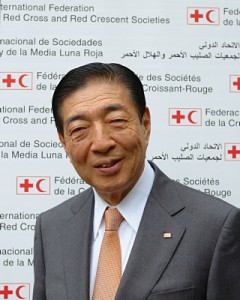It’s time to tackle disaster risk through a coalition of the willing
By Tadateru Konoé
Wednesday, 11 March 2015
 March 11 marks the passing of four years since the Great East Japan Earthquake and Tsunami devastated the country’s north-eastern coastline and triggered a further technological disaster in Fukushima, where the Daiichi nuclear reactor went into meltdown. As a result of the triple disaster, including the lingering nuclear contamination, nearly 120,000 people from Fukushima prefecture are unable to return to their homes. Most are resigned to starting new lives elsewhere.
March 11 marks the passing of four years since the Great East Japan Earthquake and Tsunami devastated the country’s north-eastern coastline and triggered a further technological disaster in Fukushima, where the Daiichi nuclear reactor went into meltdown. As a result of the triple disaster, including the lingering nuclear contamination, nearly 120,000 people from Fukushima prefecture are unable to return to their homes. Most are resigned to starting new lives elsewhere.
Japan is a world leader when it comes to disaster-resilient engineering and early warning systems, but this disaster taught us that whatever safeguards we have in place, we must also anticipate the unimaginable.
The International Federation of Red Cross and Red Crescent Societies (IFRC) has direct experience of addressing the long-term humanitarian consequences of nuclear disasters. In Chernobyl and Fukushima we continue to support the social welfare and health needs of the children, the elderly and other vulnerable groups. At a global level we are scaling up our efforts to ensure that communities are better prepared for such technological disasters. Next week, the Fukushima nuclear disaster will be part of discussions at the World Conference on Disaster Risk Reduction (WCDRR), hosted by the Japanese Government. The WCDRR brings together governments, international and civil society organizations, academia and the private sector. Together, we will develop a new, post‐2015 framework for disaster risk reduction aimed at creating safe and risk free environments for vulnerable people everywhere.
Today, people worldwide have greater opportunities for growth and connectedness than ever before; yet disaster fatalities have risen steadily over the past 20 years and communities in many places face increased risks due to the compounding effects of climate change, urbanization, limited access to economic opportunities, and shrinking natural resources and basic services.
For the post-2015 framework to be truly effective there must be a paradigm shift where national policy and commitments translate into tangible action and new patterns of partnerships in risk reduction on the ground and globally. This requires investment and strengthening of the capacities of local, city and regional authorities as well as recognition that local people and organizations must be more empowered to drive the change they want to see in their communities. They are the first responders in emergencies and they have the best knowledge and understanding of local risks.
At the WCDRR, the IFRC will be calling for the new post-2015 framework to be more inclusive of a broader ‘community resilience’ agenda that safeguards sustainable development gains and integrates disaster risk reduction together with public health, poverty reduction, and climate change adaptation strategies. We will be announcing our ‘One Billion Coalition for Resilience,’ an initiative that brings together a wide range of like-minded actors to form new partnerships and expand our reach from global to local levels. This may manifest itself in local communities working with public authorities, humanitarian organizations, the private sector and schools or universities. The coalition will improve the flow of resources to programmes and initiatives on the ground and will bring greater learning through the sharing of knowledge, experience and ideas to address common problems.
Within the next 10 years, the goal is to engage at least one person in every household around the world in active steps towards building their resilience. This could involve first aid and preparedness training, strengthening of local institutions and early warning systems, pandemic preparedness and improved access to health and water and sanitation. Focus will also be on supporting public authorities to adopt strong legal frameworks on disaster risk reduction.
Despite the challenges and threats that millions of people face, we must recognize that people, including young people, in hazard-prone communities are themselves agents of change. Helping communities to reach their potential requires new models of working together to address the barriers to resilience. It is now a matter of collective responsibility, collective action and collective accountability. While we cannot prevent another tsunami, we can build better safeguards that will offer greater protection for future generations.
Tadateru Konoé is President of the Japanese Red Cross Society (JRCS) and of the International Federation of Red Cross and Red Crescent Societies (IFRC)
 March 11 marks the passing of four years since the Great East Japan Earthquake and Tsunami devastated the country’s north-eastern coastline and triggered a further technological disaster in Fukushima, where the Daiichi nuclear reactor went into meltdown. As a result of the triple disaster, including the lingering nuclear contamination, nearly 120,000 people from Fukushima prefecture are unable to return to their homes. Most are resigned to starting new lives elsewhere.
March 11 marks the passing of four years since the Great East Japan Earthquake and Tsunami devastated the country’s north-eastern coastline and triggered a further technological disaster in Fukushima, where the Daiichi nuclear reactor went into meltdown. As a result of the triple disaster, including the lingering nuclear contamination, nearly 120,000 people from Fukushima prefecture are unable to return to their homes. Most are resigned to starting new lives elsewhere.